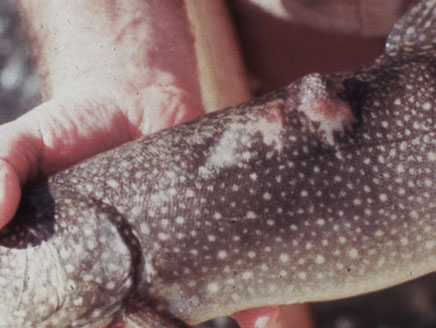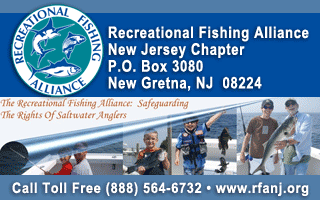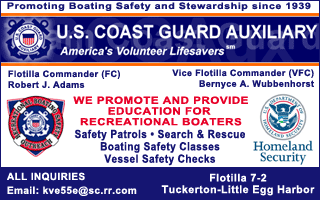
The New Jersey Division of Fish and Wildlife has just released information to the public that a fisherman has caught and photographed a rainbow trout with active lesions in the South Branch Raritan River...
By Tom Vassallo
Back in March, FishinJersey editors researched furunculosis and published a feature article warning New Jersey anglers of the danger of placing ANY trout raised in the infected Pequest Hatchery into New Jersey waters. Our position was that the fish may not be experiencing or demonstrating symptoms of the deadly disease, but may can carry the deadly bacterium. It is with great regret we must inform New Jersey anglers that the New Jersey Division of Fish and Wildlife has just released information to the public that a fisherman has caught and photographed a rainbow trout with active lesions in the South Branch Raritan River.
 |
| NJDF&W has reported that a New Jersey angler has caught and photographed a rainbow trout in the South Branch Raritan River displaying active lesions like the ones shown in the photo above from the Vermont Dept. of Fish & Wildlife, |
The following is a copy of the statement that was emailed to FishinJersey.com:
"In mid-May the Division of Fish and Wildlife conducted a preliminary fish health study in the South Branch Raritan River, specifically the Ken Lockwood Gorge, in response to a fisherman capturing an apparently diseased rainbow trout from the river. Pictures of the diseased fish showed skin and muscular lesions, consistent with clinical disease signs of furunculosis. Confirmation of furunculosis was not possible by the Division's Fish Pathologist because the fish was released by the fisherman back into the trout conservation stretch of the river.
Anglers catching apparently diseased fish, even those caught in catch and release areas, are asked to call the Fish Pathology Laboratory at the Pequest Trout Hatchery in Oxford at (908) 637-4173 (extension 120) or after hours contact the DEP Hotline (877) 927-6337, so arrangements can be made to acquire the fish for testing.
A study is being conducted at Ken Lockwood Gorge to determine the prevalence of furunculosis. The goals of the research project includes determining the prevalence of this bacterium within the Ken Lockwood Gorge, understanding the genetics of the fish affected by the bacterium, and fully characterizing the strains of the bacterium found in the river.
Furunculosis is an endemic disease caused by the bacterium Aeromonas salmonicida subspecies salmonicida. The bacterium does not pose any human health risks. Although the bacterium is endemic in North America and has been known to exist in the state for a long period of time, clinical disease in wild or stocked trout in the environment has not been documented in New Jersey until this year.
The state's Pequest Trout Hatchery suffered an outbreak of furunculosis in September of 2013. A strict fish health policy was followed to avoid the introduction of fish affected with furunculosis or suspected carriers of the bacterium into trout waters, like Ken Lockwood Gorge. No fish with a history of furunculosis were released from Pequest into any state trout waters."
After reading the carefully worded release reprinted above, it is important to note what the Division is stating in the last paragraph above. They have stated that (boldface added for emphasis):
"A strict fish health policy was followed to avoid the introduction of fish affected with furunculosis or suspected carriers of the bacterium into trout waters, like Ken Lockwood Gorge."
That is like saying that since the fish were not exhibiting symptoms or came from a different raceway that had not exhibited symptoms...those fish were healthy. In our article from March, it clearly stated that carriers may not exhibit symptoms. That may not have been the best decision, especially since (as they state above):
"Although the bacterium is endemic in North America and has been known to exist in the state for a long period of time, clinical disease in wild or stocked trout in the environment has not been documented in New Jersey until this year."
Oh...how coincidental...never an outbreak in New Jersey until Pequest Hatchery fish were placed all across the state into New Jersey's lakes and rivers. Now they say that it was unknown how the bacterium started at Pequest, but they suspected it came from ospreys and other birds of prey feeding on the hatchery fish. Well...where do those same ospreys normally feed? In New Jersey lakes and rivers. Yet prior to the Pequest trout being placed in those waters, there was NEVER an outbreak in the wild.
The troubling part of this whole story is that the bacterium that causes this fatal disease, Aeromonas salmonicida subspecies salmonicida, can also affect eels, flounder and smallmouth bass which are also inhabiting the South Branch Raritan River. American eel stocks along the U.S. Atlantic coast underwent a status review in 2005 in response to a petition to list the species as threatened or endangered under the Endangered Species Act of 1973. The results of the status review are still pending. But most reports still show a declining population. Even more troubling is the fact that the South Branch Raritan River is listed as one of the key areas for smallmouth bass fishing in the entire state of New Jersey. It could be devastating to the New Jersey Smallmouth fishery if the population there becomes infected.
The editors at FishinJersey.com will keep all our readers and web site visitors apprised of any new developments in this story. We will also keep our fingers crossed that the smallmouth bass population will remain unaffected by the other diseased fish found in the river.















